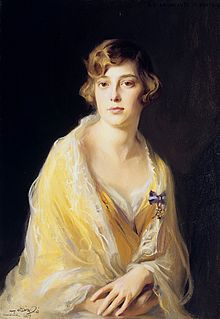Beatrice Isabel de Borbon y Battenberg

Beatriz Isabel de Borbón y Battenberg , full name Beatriz Isabel Federica Alfonsa Eugenia Christina Maria Teresa Bienvenida Ladisláa de Borbón y Battenberg (born June 22, 1909 in the Palacio Real La Granja de San Ildefonso in Madrid ; † November 22, 2002 in Rome ) was an infanta of Spain and aunt of the Spanish King Juan Carlos I.
Life
childhood
Beatriz Isabel was the eldest daughter of the Spanish King Alfonso XIII. (1886–1941) and his wife Victoria Eugénie von Battenberg (1887–1969), daughter of Heinrich Moritz von Battenberg and Beatrice of Great Britain and Ireland . Her paternal grandparents were King Alfonso XII. and his second wife Maria Christina of Austria . She was named Beatriz in honor of her maternal grandmother and Isabel after Princess Isabella of Spain .
She and her sister Maria Christina, who was two years younger than her, were raised by an English nanny . Beatriz Isabel learned her mother tongue Spanish as well as English and French. She also received lessons in history, religion, playing the piano, dancing and horse riding . Her parents were very careful that the children were outdoors a lot and played sports. Beatriz Isabel liked to play tennis and was considered an outstanding swimmer.
Together with her sister she often traveled to England to visit her family, especially Princess Beatrice, at Kensington Palace .
Adulthood and Life in Exile
She had a liaison with her cousin (second degree) Alvaro d'Orleans-Bourbon (1910-1997), the eldest son of Beatrice von Sachsen-Coburg and Gotha . A marriage did not materialize, however, because both carriers of the hereditary disease haemophilia (blood disease) were. The separation took place in 1931. On April 14, 1931, the Republic of Spain was proclaimed and her father, King Alfonso XIII, went into exile on the same day without a formal abdication . The royal family went first to Paris and shortly afterwards to Fontainebleau . Her parents' marriage was considered unhappy. Her father had various affairs and several illegitimate children. From 1933 the parents lived separately and Alfons moved to Rome with his daughters, Beatriz Isabel and Maria Christina.
Starting a family
On January 14, 1935, Beatriz Isabel married Don Alessandro Torlonia , 5th Principe di Civitella-Cesi (1911-1986), son of the banker Prince Marino Torlonia and his wife Mary Elsie Moore, an American industrialist in Rome . After the church ceremony , the bride and groom were welcomed by Pope Pius XI. receive. The marriage had four children:
- Sandra Vittoria (1936–2014) ⚭ 1958 Count Clemente Lecquio di Assaba (1925–1971)
- Marco Alfonso (1937-2014)
- ⚭ 1960 Orsetta Caracciolo di Castagneto (1940–1968)
- ⚭ 1968–1975 Philippa Catherine McDonald (* 1942)
- ⚭ 1985 Blažena Anna Helena Svitáková (* 1940)
- Marino Riccardo Franceso Maria Giuseppe (1939–1995)
- Olimpia Emanuela Enrichetta Maria (* 1943) ⚭ 1965 Paul-Annik Weiller (* 1933)
Her husband, Alessandro Torlonia, was a great-uncle of the American film and television actress Brooke Shields .
On November 22nd, 2002 Beatriz Isabel died at the old age of 93 in the Palazzo Núñez-Torlonia in Rome. She was the last living child of King Alfonso XIII. and Queen Victoria Eugénie.
literature
- Arnold McNaughton: The Book of Kings: A Royal Genealogy , London (1973)
Web links
| personal data | |
|---|---|
| SURNAME | Borbón y Battenberg, Beatrice Isabel de |
| ALTERNATIVE NAMES | Borbón y Battenberg, Beatriz Isabel de; Borbón y Battenberg, Beatriz Isabel Federica Alfonsa Eugenia Christina Maria Teresa Bienvenida Ladisláa de |
| BRIEF DESCRIPTION | Spanish noblewoman, Infanta of Spain and aunt of the Spanish King Juan Carlos I. |
| DATE OF BIRTH | June 22, 1909 |
| PLACE OF BIRTH | Madrid |
| DATE OF DEATH | November 22, 2002 |
| Place of death | Rome |

